Rescuing The Defensive Back
4 tips & 6 drills for better secondary play
Recent styles of offenses have forced defensive schemes to change. New defenses, like the 3-3-5, 3-5-3 or modified 40 fronts have emerged in response to the shift in today’s offensive philosophy toward a more open format. Offenses now are looking to isolate defenders, especially in the secondary.
Defensive backs at all levels are finding themselves on “islands of isolation” while playing a lot of 1-on-1 coverage…or looking like they simply want to survive until the next play. The days of the defensive coordinator simply telling his best athlete to play defensive back and cover the offense’s most-skilled player are over.Now, it is important for the defensive back (corner or safety) to develop the skills necessary to match the play of the skilled offensive player or scheme that needs to be defended.
The following are four tips to improve your secondary play followed by six drills to sharpen the skills of your defensive backs and safeties.
1. Stances & Starts
Everything starts with a proper stance for your secondary players. Have them positioned in a staggered stance with a relaxed posture, hips low (like sitting in a chair) and hands in front of the body. Have them place more weight on the toes and less on the heels. A straight-up standing posture with feet balanced causes false steps and it takes the player too long to get his body in motion.
Secondary players’ eyes need to be focused on the offensive formation (the pre-snap read) and the player is ready for action when the quarterback begins his cadence. A great way to test your secondary’s stance and initial movement is to place them in a straight line, have them get into a proper stance and give a cadence like you are the quarterback. Then, have them take three read steps emphasizing “nose over the toes” while backpedaling.
2. Defending & Closing Skills
“Bite the hip” (of the offensive player) is a phrase I use constantly to remind our defensive backs about the closing angle and distance he needs to be in relation with the skilled player. Hip movement, reaction to the play and correct position to the offensive player (or overall play) is important. No coach wants his secondary covering grass while the play goes past the defenders.
To sharpen closing skills, use cones or marks on the field to show the defensive backs where proper depth and position are. Work with the secondary on taking the proper angle, which, mostly, is a 45-degree angle.
3. Improving Group Play
Working within a group at practice is important for defensive backs because it allows them to apply their drill work and new skills in a team setting. Run a lot of 7-on-7s and pass skeletons to see where your secondary is strong and where it needs work. Be sure to accentuate the positive as often as you can…most players do not get enough of that on the football field.
To make sure players work together as a team, have them focus on the following assignments when facing a live offense (instead of the motions of drill work).
X Alignment & Assignment. Secondary players need to understand where to line up and what to do when the play begins. Some of this is instinctive but this is where repetitive drill work helps them. Provide them with landmarks on the field for their assignment like: middle of the field, goal posts or directly on the offensive player. Provide them with a starting yardage depth of four, six or eight yards.
Don’t simply expect players to know where to line up and what is their specific assignment. One of the leading mistakes on the defensive side of the ball is improper starting alignment as it places undo pressure on an otherwise solid defensive scheme.
X Know The Down & Distance. Bring out a pair of old line markers during group or team time at practice to emphasize the point of always knowing the down and distance. Have the secondary players shout out the down and what to look for based on the scouting of the upcoming opponent.
X Formation Recognition. Scouting reports, group work and film time help the defensive backs for on-the-field play. The more they see the offensive schemes of other teams, the better they become at playing against them. Once the formation is recognized, have secondary players pay attention to motion, offensive changes at the line of scrimmage and adjustments in body position.
X Communication. You need your secondary players to be coaches on the field. Be sure your players know the importance of verbally communicating to each other prior to the start of the play. If noise is a factor or you want to keep the offense on its toes, use signals without words.
4. Be Physical
Knowing the defense is important but you also need your secondary players to react instinctively to what is happening in front of them during a play. Teach your players to trust their eyes and don’t second-guess themselves.
Spend some of your practice time at the sled to focus on tackling and reaction drill work. Players show marked improvement, which leads to more confidence, the more time they spend on tackling. It doesn’t come naturally to all defensive backs.
6 Secondary Drills
The best way to reduce errors in your secondary is to work the proper skills, movements and reactions needed. Use the following six drills during your practices.
X “W” Drill. This drill forces defensive backs to turn their hips, change direction and work on stance, starts and backpedal skills.
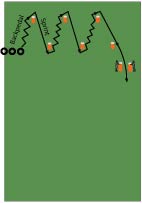
DIAGRAM 1: “W” Drill. Place markers five yards apart. Players start in a proper stance and backpedal past the first marker, then sprint forward to the next marker. Players then backpedal again to the next marker, sprint to the one after that, etc. The drill ends when the player breaks down and rips through two blockers with hand shields. Keep this drill moving by having the second player begin his progression with the first player reaches the second marker.
X Diamond Drill. This drill emphasizes proper position on the offensive player when covering in man or zone situations. Work with the defender to get his proper hand up in front of the receiver. 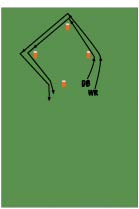
DIAGRAM 2: Diamond Drill. Set the cones 10 yards apart and on the coach’s command have the defensive back (DB) and wide receiver (WR) leave together with the DB on the inside of the WR (running at three-quarters speed). When the two players reach the first marker, the WR chops his feet to simulate a cut move and the DB throws his inside (back) hand up to remain close to the WR to make a play (remember the “bite the hip” phrase from Tip 2).
Players continue around each marker until they reach the end. If you want, add a ball, and throw it when the players reach any of the markers.
X Knock-Down Drill. This drill emphasizes proper hand position in knocking down passes, as well as how to react to the pass. During this drill, make sure the DB has his feet moving and takes the proper angle to the ball.
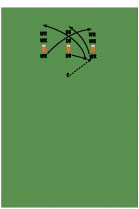
DIAGRAM 3: Knock-Down Drill. Place players in three lines with the middle line as the DB. Lines are set two to three yards apart (as the players get better at reaction, move the lines to a 10-yard width). The coach throws a pass to one of the two receivers (no fake passes as the ball needs to go directly to the target).
The DB reacts and tries to knock the ball down. When the action is complete, the DB goes to the end of the left line. The WR in the left line goes to the back of the right line. The WR in the right line goes to the end of the DB line. Make sure everyone has three tries at knocking down passes.
X Sled Work. Bring out the sleds to emphasize hand and foot work. Have your DBs execute forearm shivers that are at a 45-degree angle. Instruct your DBs to stay low, to keep his feet moving and to not spread his feet too wide when tackling. Try this drill at the end of a period or just prior to a water break.
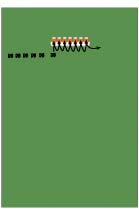
DIAGRAM 4: Sled Work. Each player executes a forearm shiver starting at the first pad. On the command, the player chops his feet and when the whistle blows, he hits the pad low and hard with his left forearm at a 45-degree angle while keeping the body low, then moving to the next pad.
The next player in line steps into the action and chops his feet while waiting for the whistle. On the whistle, the first player executes the forearm shiver again on the second pad while the new player hits the first pad. The drill continues until all players have moved all the way down the sled.
Next, have your players execute hand shivers, which require the DB to hit the sled pad with an open palm. Finish with the DBs tackling the pad with the right shoulder down and the left shoulder back. The emphasis in the tackling part is to lift the pad on the first whistle and dropped it on the second whistle.
X Wave Drill. The purpose of the Wave Drill is to get the hips of the DB turned and in a position to make a play — whether the offense is running or passing. Instruct your players to take the proper 45-degree angle to cut off receivers, open hips properly, close on the ball with the correct angles and by ready to make a tackle.
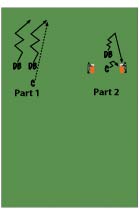
DIAGRAM 5: Wave Drill. The first part of this drill has a couple of players starting in a three-step backpedal on the coach’s command. The players turn their hips and body toward the direction of the ball while keeping their eyes on the passer. As the passer moves, the DBs yell, “Pass!” When the ball is released, the defender moves to knock it down or catches it at its highest point.
The second part of the drill adds the run support. On the coach’s command, the DB takes three read steps and changes direction on the passer’s movement. But, this time, when the passer brings the ball down simulating a run, the DB immediately changes direction and rips through the hand shield on the appropriate side (where the passer has moved).
X Shadow Drill. The Shadow Drill teaches proper technique with zone coverage and proper position by the DB on the WR. This drill also allows you to use pattern recognition and to work on proper coverage techniques within a zone scheme. Make sure your players close at proper angles to the ball.
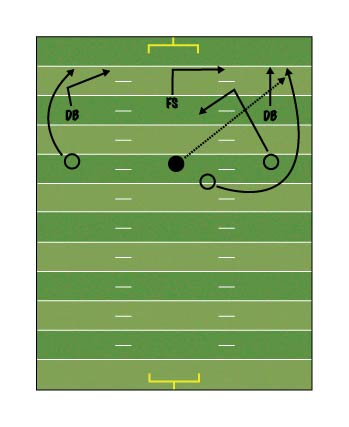
DIAGRAM 6: Shadow Drill. Set the secondary in a three- or four-player look (in the diagram, it’s a three-player look). Call the coverage, then send two to three WRs into the field running patterns at different depth at the secondary. Throw the ball to one of the WRs.
Make sure that every DB is closing toward the ball once it is in the air. Defenders are to knock down the ball, intercept the pass or be in a position to make the tackle.





